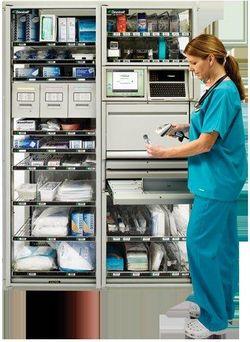Omnicell cabinets get medication orders directly from Cerner electronic health record software at Montana's Billings Clinic, eliminating dangerous duplicate orders.


8 Healthcare Startups Catch Fire
8 Healthcare Startups Catch Fire (click image for larger view and for slideshow)
The Billings Clinic healthcare system, headquartered in Billings, Mont., is closing the loop between its Cerner electronic health records software and its medication management system. Billings is the first healthcare organization to implement a tight integration between Cerner and the medication cabinets made by Omnicell, which come with their own software for controlling and tracking the drugs they dispense.
By having the EHR send medication orders directly to the cabinets, this integration improves productivity and also patient safety. It takes advantage of Cerner's CareAware iBus software for medical device integration in place of a looser integration based on HL7 messaging that had been in place previously. Originally introduced into the hospital to safeguard controlled substances, the medication management cabinets had come to be used for the majority of drugs because the Omnicell system introduces safety checks, such as requiring a pharmacist's approval before a drug is dispensed. But it turned out there was room for improvement.
"We're always looking for ways to make things better," said Jacob Thiesse, a pharmacist and informatics specialist at Billings Clinic. One of the reasons Billings was interested in the first place was that the hospital had identified several medical errors based on HL7 messaging glitches that left the two systems out of sync, meaning that the data available to pharmacists and nurses "was not necessarily the most accurate picture of what the patient had gotten," he said. As far as he knows, in each case the error was caught before a double dose was administered or some other serious complication ensued -- but the errors were still cause for concern.
The first corrective action the hospital took was to put a laptop for accessing the EHR next to the pharmacy cabinet, making it easier for a nurse to cross-reference the two systems. However, that created some duplicative work, so Billings was interested when it heard Omnicell was looking for someone to test a tighter software integration. The hospital was also interested in further tapping the iBus integration software, which it also has begun using to send data from devices such as heart monitors directly into the EHR. Other pharmacy applications the hospital is investigating include infusion monitoring, Thiesse said.
[What bugs docs most about electronic health record systems? Read Why Doctors Hate EHR Software.]
Omnicell is based in Mountain View, Calif., and its OmniRX system has been the top-ranked pharmacy automation system for eight years running, according to the KLAS survey of healthcare technology buyers. An Omnicell cabinet is "almost like an ATM for drugs," a secure device for dispensing them only with proper authorization, said Kristin Russel, senior director of product innovation at Ominicell. Although the hardware is important, Omnicell has been putting increasing emphasis on software and software integration. The connection with Cerner is the deepest integration Omnicell has achieved with an EHR so far, although a year ago it also introduced integrated reporting on drug orders and dispensing with healthcare software from Siemens.
In the case of Cerner, the Omnicell system can function as an extension of the EHR. "If I'm a nurse, I want to be able to go to any computer to queue up medications for the patient to take and have medications ready by the time I get to the cabinet," Russel says. In the past, the more common pattern might have been to copy the information from the EHR onto a slip of paper and then enter it into the Omnicell software. "We're getting rid of that gap and potential for errors," she says.
Omnicell and Cerner plan a second phase of even tighter integration between the dispensing system and the EHR.
Randy Lantz, VP of engineering for Cerner DeviceWorks, said this is not the first time the Cerner Millennium EHR has been integrated with medication management systems but the iBus integration is an improvement over solutions based on HL7. HL7 is a standard messaging format for passing clinical information between software applications or even between institutions in health information exchange scenerios.
"While HL7 is a standard and very prevalent in the industry, it can be difficult to implement and requires a fair amount of management," Lantz said. The iBus technology allows much tighter and faster integration, he said. "With this architecture, we're at a tier just above the database. We're listening for events in near-real time as they're written to the database and notifying Omnicell."
The integration also takes advantage of the Cerner MPages development tool for creating custom screens and custom workflows for the combined Millennium to Omnicell functionality, he said. "Before, clinicians were dealing with two disparate systems," he said, which meant the same steps performed in the EHR had to be replicated at the medication cabinet. "With this integration, they're fundamentally doing that one time in the MPage," he said.
Though the online exchange of medical records is central to the government's Meaningful Use program, the effort to make such transactions routine has just begun. Also in the Barriers to Health Information Exchange issue of InformationWeek Healthcare: why cloud startups favor Direct Protocol as a simpler alternative to centralized HIEs. (Free registration required.)
About the Author(s)
You May Also Like







